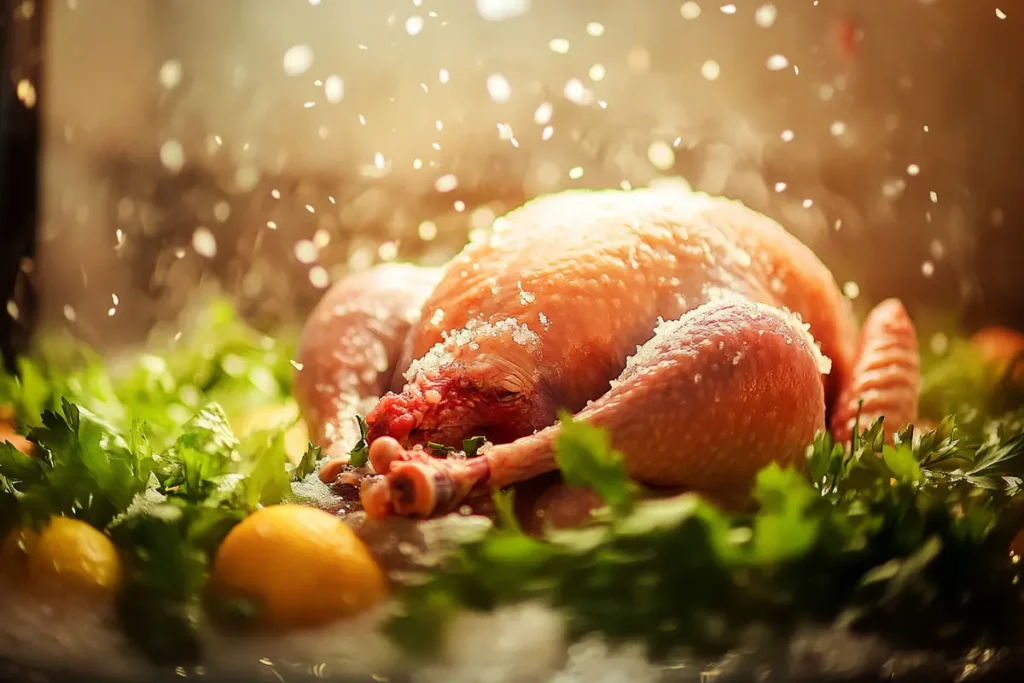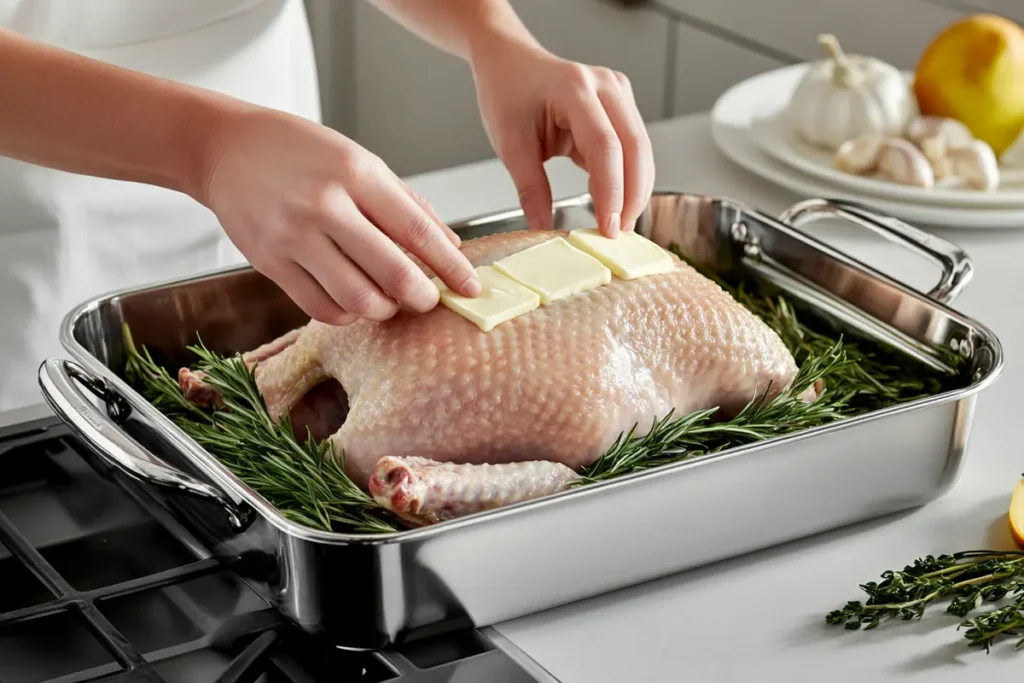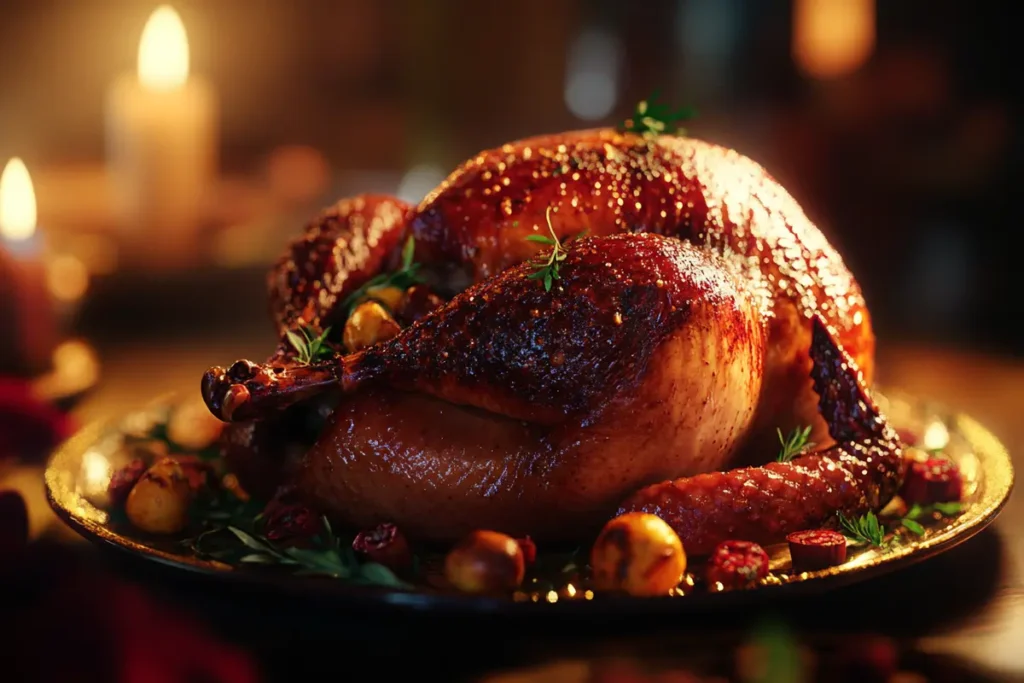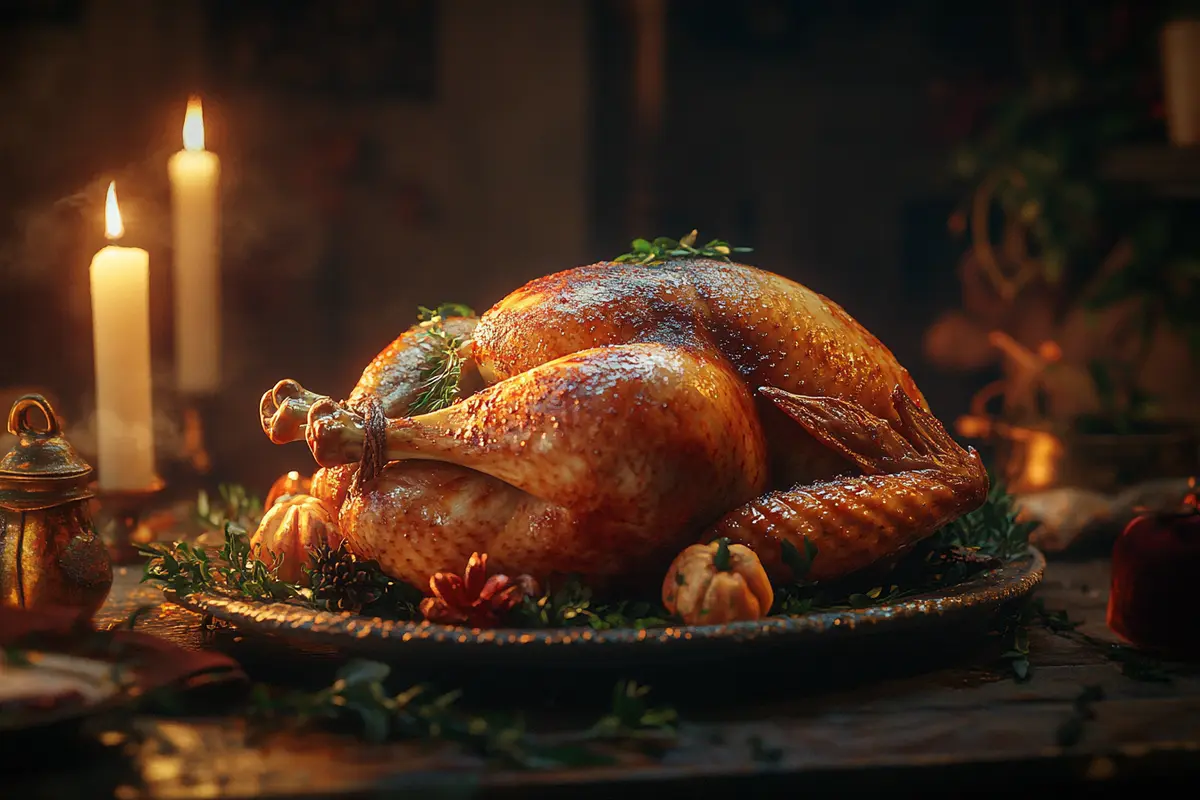Learn how to prepare the perfect juicy Thanksgiving turkey with these expert tips, step-by-step recipe, and techniques to ensure a moist, flavorful bird.
Introduction
Thanksgiving is not complete without a centerpiece—a beautifully roasted juicy Thanksgiving turkey. However, cooking a turkey that remains juicy, tender, and flavorful can be challenging. With the right methods, anyone can achieve a golden, crispy exterior and a succulent interior. In this guide, we’ll walk you through the entire process, from preparation to serving, so you can impress your guests with the best juicy Thanksgiving turkey.
If you’re looking for ways to make your Thanksgiving turkey special, the good news is that simple adjustments in technique and preparation can yield extraordinary results. Whether you’re a seasoned cook or a first-time turkey roaster, our guide will help you get the most out of your bird. To better understand the science behind keeping meat juicy, check out this detailed article on brining and its effects on poultry. Additionally, for more tips on creating a successful Thanksgiving meal, this helpful guide on holiday cooking might come in handy.
Cooking a perfect turkey isn’t just about following a recipe—it’s about understanding the methods that make your bird stay moist. In this guide, we’ll explore the various steps and techniques, including brining, seasoning, and roasting, that will guarantee your juicy Thanksgiving turkey is the highlight of your feast.
The Secret to a Juicy Thanksgiving Turkey
The key to cooking a juicy Thanksgiving turkey is in the preparation and cooking techniques. There are several methods to ensure the meat stays moist and tender, such as brining, basting, and monitoring cooking temperatures. Below, we will explain these steps in detail.
Brining the Turkey
Brining is one of the most effective ways to ensure a juicy bird. A brine is a solution of salt and water, often combined with sugar, herbs, and spices, that helps to infuse the turkey with moisture and flavor. There are two main types of brining—wet brining and dry brining.
- Wet Brine: This involves submerging the turkey in a saltwater solution for 12 to 24 hours. The salt breaks down muscle proteins, allowing the meat to absorb water and stay juicy during cooking.
- Dry Brine: This involves rubbing the turkey with salt and other seasonings and letting it rest uncovered in the refrigerator. This method is less messy than wet brining and still helps retain moisture.
For more information on the differences between wet and dry brining, see this guide on brining methods.

Seasoning and Stuffing the Turkey
Seasoning the turkey is crucial for achieving great flavor. In addition to salt and pepper, you can use herbs like thyme, rosemary, and sage to add depth. Rubbing butter or olive oil under the skin also helps keep the turkey moist while imparting a rich flavor.
When it comes to stuffing, it’s important to note that stuffing the cavity with aromatics—such as onion, garlic, lemon, and herbs—can help keep the turkey moist and infuse it with flavor. However, cooking stuffing inside the bird can affect cooking times and safety, so many cooks prefer to bake the stuffing separately to ensure even cooking.
Roasting Techniques for a Juicy Thanksgiving Turkey
- Use a Roasting Rack: Placing the turkey on a roasting rack allows air to circulate around the bird, promoting even cooking and preventing the bottom from becoming soggy.
- Cover with Foil: Tent the turkey with aluminum foil during the first part of cooking to prevent the skin from browning too quickly. Remove the foil during the last hour to achieve a crispy, golden skin.
- Basting: Basting the turkey with pan drippings every 30 minutes can help maintain moisture. However, opening the oven frequently can lower the temperature, so it’s important to balance basting with consistent cooking.
- Monitor the Temperature: Using a meat thermometer is key to ensuring your turkey is perfectly cooked. The internal temperature of the thickest part of the breast should reach 165°F, while the thigh should be around 175°F.
Step-by-Step Recipe for a Juicy Thanksgiving Turkey
Below is a detailed recipe to help you prepare a delicious and juicy turkey for your Thanksgiving celebration.
Ingredients
- 1 whole turkey (12-14 pounds)
- 1 cup kosher salt (for brine)
- 1/2 cup sugar (optional, for brine)
- 1/4 cup unsalted butter, softened
- 2 tablespoons olive oil
- Fresh herbs: thyme, rosemary, sage
- 1 onion, quartered
- 1 lemon, halved
- 4 cloves garlic, crushed
- Salt and black pepper to taste
Instructions
- Prepare the Brine: In a large pot, combine the salt, sugar, and enough water to submerge the turkey. Stir until the salt and sugar are dissolved. Place the turkey in the brine and refrigerate for 12-24 hours.
- Season the Turkey: After brining, remove the turkey from the brine and pat it dry with paper towels. Rub the softened butter under the skin of the turkey breast, and coat the outside with olive oil. Season generously with salt, pepper, and herbs.
- Stuff the Cavity: Place the onion, lemon, garlic, and herbs inside the cavity of the turkey. This will help infuse the bird with aromatic flavors.
- Preheat the Oven: Preheat your oven to 325°F (165°C).
- Roast the Turkey: Place the turkey on a roasting rack in a large roasting pan. Tent loosely with foil and roast for approximately 13-15 minutes per pound. Remove the foil during the last hour to allow the skin to brown.
- Baste the Turkey: Baste the turkey with pan drippings every 30-40 minutes for extra moisture.
- Check the Temperature: Insert a meat thermometer into the thickest part of the breast and thigh. The breast should read 165°F, and the thigh should reach 175°F.
- Rest Before Carving: Let the turkey rest for at least 20-30 minutes before carving. This allows the juices to redistribute, resulting in a juicier turkey.

Tips for Keeping the Turkey Juicy
- Do Not Overcook: Overcooking is the most common reason for a dry turkey. Monitor the temperature closely to avoid this.
- Resting Period: Allowing the turkey to rest after cooking is crucial. This helps the juices settle, keeping the meat moist when sliced.
- Use a Meat Thermometer: A reliable meat thermometer is your best tool for avoiding an overcooked or undercooked turkey.
Common Mistakes to Avoid
Overstuffing the Turkey
Stuffing the turkey with too much filling can lead to uneven cooking. It also makes it harder for the heat to reach the center, which can result in undercooked stuffing or an overcooked bird. Instead, use a small amount of aromatics for flavor and bake any additional stuffing separately.
Not Drying the Skin
For crispy skin, make sure to pat the turkey completely dry before applying butter or oil. Excess moisture can lead to steaming rather than roasting, which prevents the skin from becoming crispy.
Opening the Oven Too Often
Opening the oven door frequently to baste the turkey can cause temperature fluctuations that affect the cooking time and texture. Instead, limit basting to once every 30-40 minutes to retain consistent heat.
Delicious Side Dishes to Pair with Your Juicy Thanksgiving Turkey
A juicy Thanksgiving turkey deserves equally delicious side dishes. Here are some ideas for sides that complement the flavors of the turkey:
- Garlic Mashed Potatoes: Creamy mashed potatoes with roasted garlic add a rich, buttery flavor that pairs perfectly with turkey.
- Green Bean Casserole: A classic casserole made with fresh green beans, cream of mushroom soup, and crispy onions for added texture.
- Cranberry Sauce: The tartness of cranberry sauce cuts through the richness of the turkey, providing a refreshing contrast.
- Cornbread Stuffing: Cornbread stuffing with celery, onion, and herbs is a flavorful addition that soaks up the turkey juices well.
- Roasted Root Vegetables: Carrots, parsnips, and sweet potatoes roasted with olive oil, salt, and herbs make for a colorful and nutritious side dish.
More Techniques for a Juicy Thanksgiving Turkey
Spatchcocking the Turkey
Spatchcocking is a method where the turkey’s backbone is removed, allowing it to lay flat during roasting. This method not only reduces cooking time but also helps the bird cook more evenly, resulting in juicy breast meat and fully cooked dark meat.
- Remove the Backbone: Place the turkey breast-side down and use kitchen shears to cut along both sides of the backbone. Remove the backbone and save it for making stock or gravy.
- Flatten the Turkey: Turn the turkey breast-side up and press firmly on the breastbone until the bird lies flat. Season as desired and roast on a baking sheet or roasting rack.
Butter Injection
For an extra burst of flavor and moisture, consider injecting the turkey with seasoned melted butter or broth before roasting. This ensures that the interior remains juicy while adding a depth of flavor.
- How to Inject the Turkey: Use a kitchen injector to inject the butter mixture into the thickest parts of the breast, thighs, and legs. This will help distribute the flavor throughout the bird.
- Butter Mixture Recipe: Combine melted butter, garlic, herbs, and a splash of lemon juice for a rich and aromatic injection.
How to Carve a Juicy Thanksgiving Turkey
Proper carving is essential for serving a juicy Thanksgiving turkey. Follow these steps to carve like a pro:
- Let the Turkey Rest: After roasting, allow the turkey to rest for 20-30 minutes. This keeps the juices in the meat rather than running out during carving.
- Remove the Legs and Thighs: Use a sharp knife to cut through the skin between the breast and leg. Gently pull the leg away from the body, cutting through the joint to separate.
- Slice the Breast Meat: Starting at the top of the breast, make even slices along the grain. This ensures the breast meat remains tender and juicy.
- Carve the Wings: Finally, remove the wings by cutting through the joint where the wing attaches to the body.

Storing and Reheating Leftover Turkey
Leftover juicy Thanksgiving turkey is great for sandwiches, soups, and casseroles. Here are some tips for storing and reheating:
- Storage: Store leftover turkey in airtight containers in the refrigerator for up to 4 days.
- Freezing: Freeze turkey meat in freezer-safe bags or containers for up to 3 months. Make sure to label the date.
- Reheating: Reheat turkey in the oven at 325°F, covered with foil, to prevent it from drying out. Alternatively, reheat in a skillet with a bit of broth to add moisture.
Frequently Asked Questions
What Is the Secret to a Juicy Turkey?
The secret to a juicy Thanksgiving turkey lies in proper preparation. Brining the turkey, seasoning well, and monitoring cooking times all contribute to a juicy bird. Additionally, letting the turkey rest after cooking allows the juices to redistribute, ensuring moist meat throughout.
What Can I Stuff My Turkey With to Keep It Moist?
To keep your turkey moist, stuff it with aromatics like onion, lemon, garlic, and fresh herbs. These ingredients help infuse moisture and flavor into the meat. Avoid dense stuffing, as it can impact the overall cooking time and may lead to dryness.
What Are Two Ways to Keep Turkey from Drying Out?
- Brining: Brining helps the turkey absorb additional moisture, making it less likely to dry out during roasting.
- Basting: Basting the turkey with pan drippings helps maintain moisture on the surface of the bird, keeping it juicy and flavorful.
How Can I Add Extra Flavor to My Turkey?
To add extra flavor to your juicy Thanksgiving turkey, consider using a combination of dry brining and an herb butter rub. Injecting the turkey with seasoned butter also adds a rich, savory taste throughout the meat.
Should I Use a Cooking Bag for My Turkey?
Using a cooking bag can help retain moisture and reduce cooking time. The steam generated within the bag helps keep the meat tender and juicy. However, if you prefer crispy skin, remove the bag during the final part of cooking to allow the skin to brown.
How Long Should I Let the Turkey Rest?
Letting the turkey rest for at least 20-30 minutes after cooking is crucial. This resting period allows the juices to redistribute throughout the meat, ensuring each slice is moist and flavorful.

